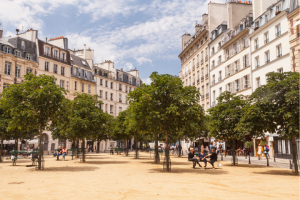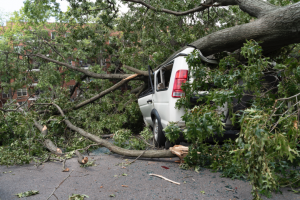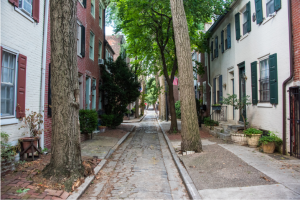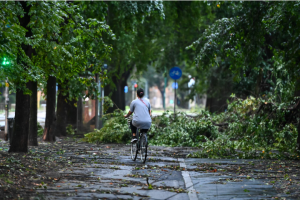From time to time, especially during a major storm, the media will report the death of a person caused by a falling tree. In some cities, parks are closed during extreme weather events to prevent such accidents. Urban trees bring us many benefits, and the last thing we expect is to be killed by them. But poor historical planning of urban tree planting, now exacerbated by climate change, means that many trees are a potential threat.
In the churchyard of St Andrew’s Church in the neighbourhood of Totteridge in the London Borough of Barnet, England, stands a yew tree thought to be 2,000 years old, dating back to the founding of the Roman town of Londinium. This tree is a survivor of the city that grew up around it. Green cities are an older invention than we might think; there are records of street trees from before the 10th century in China and at least as far back as the 17th century in Europe. As cities expanded, only a few, such as the Totteridge yew, escaped being felled. But in more modern times, cities have tried to compensate for this loss by replanting trees to create more sustainable urban spaces.
Unsustainable trees
No one would deny that a tree-lined street is much more pleasant than one of just concrete and asphalt, but the benefits of urban trees go far beyond shade or aesthetic taste: they mitigate the heat island effect through shade and evaporation, reducing the need for air conditioning; they sequester large amounts of carbon, helping to combat climate change; they reduce air, noise and water pollution, improving the health of citizens; they promote well-being and quality of life; they support urban biodiversity; and their permeable soils reduce flooding.

The problem arises when the trees themselves become literally unsustainable, i.e. when they fall over. Traditionally, species have been chosen for their aesthetic qualities and their ability to provide shade, rather than for their suitability, let alone their biology. According to landscape architect Henry Arnold, “sustainability for trees in the city cannot be achieved because the natural cycles have been interrupted there.” Narrow tree wells surrounded by concrete, poor soil and insufficient subsoil for root growth—restricted by underground infrastructure such as sewers or tunnels—can all negatively affect the survival of trees and eventually cause them to topple over.

According to Jean-Claude Ruel, an urban tree expert at Laval University (Canada), construction often affects the stability of trees: if the tree canopy shrinks, trees become less resistant to strong winds. If the surface become impermeable, the tree can dry out and fall. If the root system is damaged during excavation, the ability of the tree to withstand uprooting is reduced, and “this effect may persist for several years after the initial damage,” creating a latent threat. “Severely damaged trees will take time to recover, making them more vulnerable to other stresses.” According to botanist Gregory Moore of the University of Melbourne, a tree falling in a storm can be the result of damage inflicted on the roots 10 to 15 years earlier.
The impact of climate change
Climate change is making these problems worse. Obvious factors include heat waves and droughts in cities, but also extreme wind events, heavy snowfalls and pest invasions that are exacerbated by warming. According to a study of more than 3,100 tree species in 164 cities across 78 countries, 56% of them are experiencing temperatures and 65% precipitation conditions outside their safety thresholds. If current trends continue, these figures are expected to surpass 70% by 2050. Most worrying, in some cities, such as Barcelona, all trees are currently in a climate that is unsafe for them.

Not all species suffer to the same degree: a study by Western Sydney University (WSU) found that it is the functional traits of certain species, rather than their geographical origin or whether they are native or imported, that make them particularly vulnerable to drought, and therefore to dying and falling over. These include London plane (Platanus x acerifolia) and black locust (Robinia pseudoacacia), which are very common in urban areas. The authors also found that the water loss of trees due to extreme heat exceeds that predicted by models. “Hotter, longer, and more frequent heatwaves will require selection of more climate-resilient species in urban forests,” the authors write.
Unlike in the past, there is now a tendency to view the ecology of cities as coherent functional ecosystems, a living infrastructure, which includes urban planning that is more scientific in the selection of tree species to ensure their sustainability. This does not mean it is easy. According to WSU urban ecology climate change specialist Manuel Esperon-Rodriguez, “the effects of climate change on urban forests remain poorly understood and quantified, constraining the ability of governments to incorporate climate change resilience into urban forestry planning.”

For existing trees, Moore argues that the only solution is better management. Waterlogged soils or direct root damage can be prevented. Dead or dying tree limbs should be removed. A strong wind in an unusual direction is a warning sign, as trees tend to anchor their roots according to the prevailing wind. This is not about uprooting urban trees, nor is it about an “act of God” or “Mother Nature’s fury”; “such descriptions obscure the role of good management in minimising the chance a tree will fall.” Moore estimates that fewer than three trees in 100,000 will fall during a storm. The risk is small, but there is no need to tempt fate.
Javier Yanes
Comments on this publication